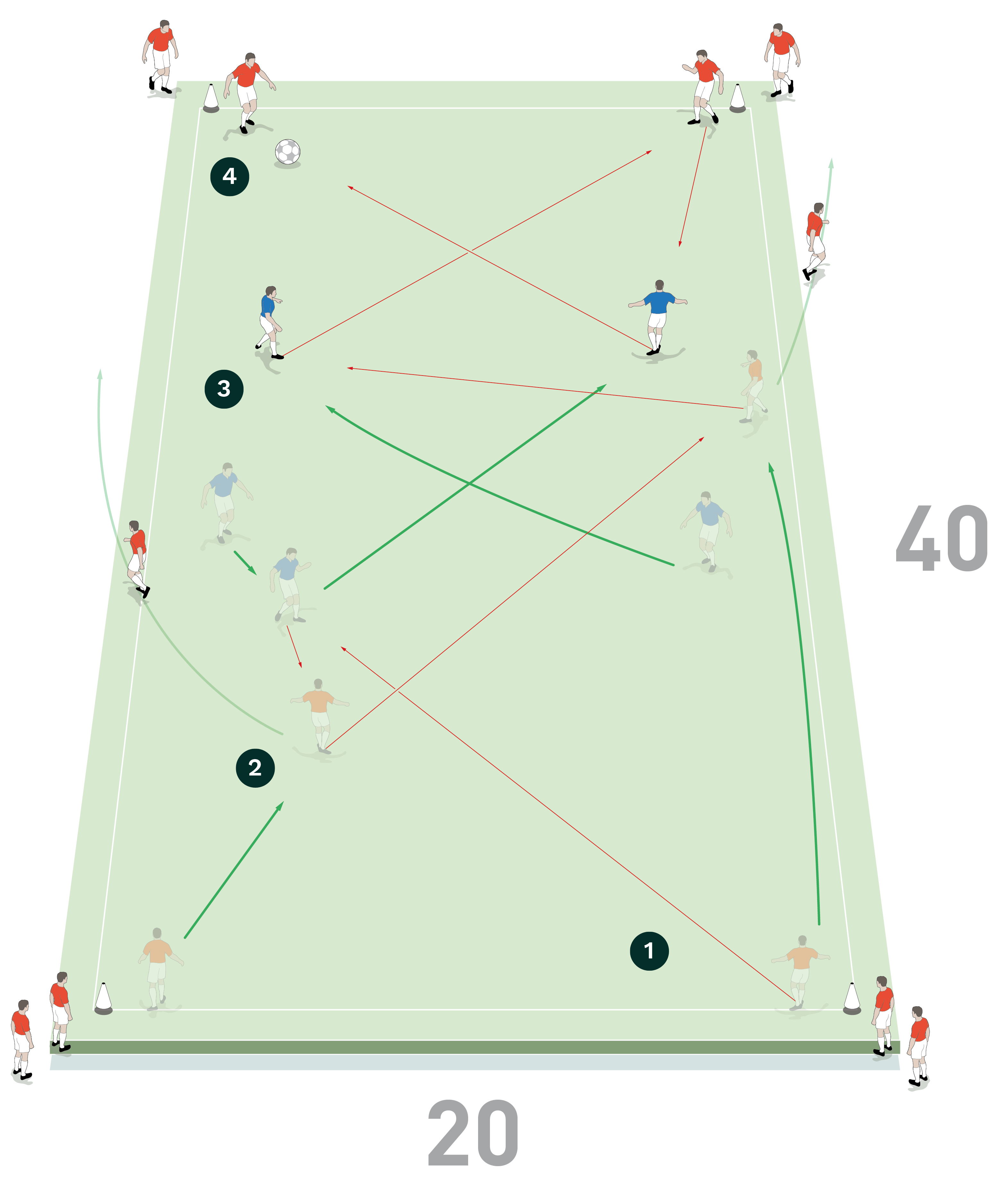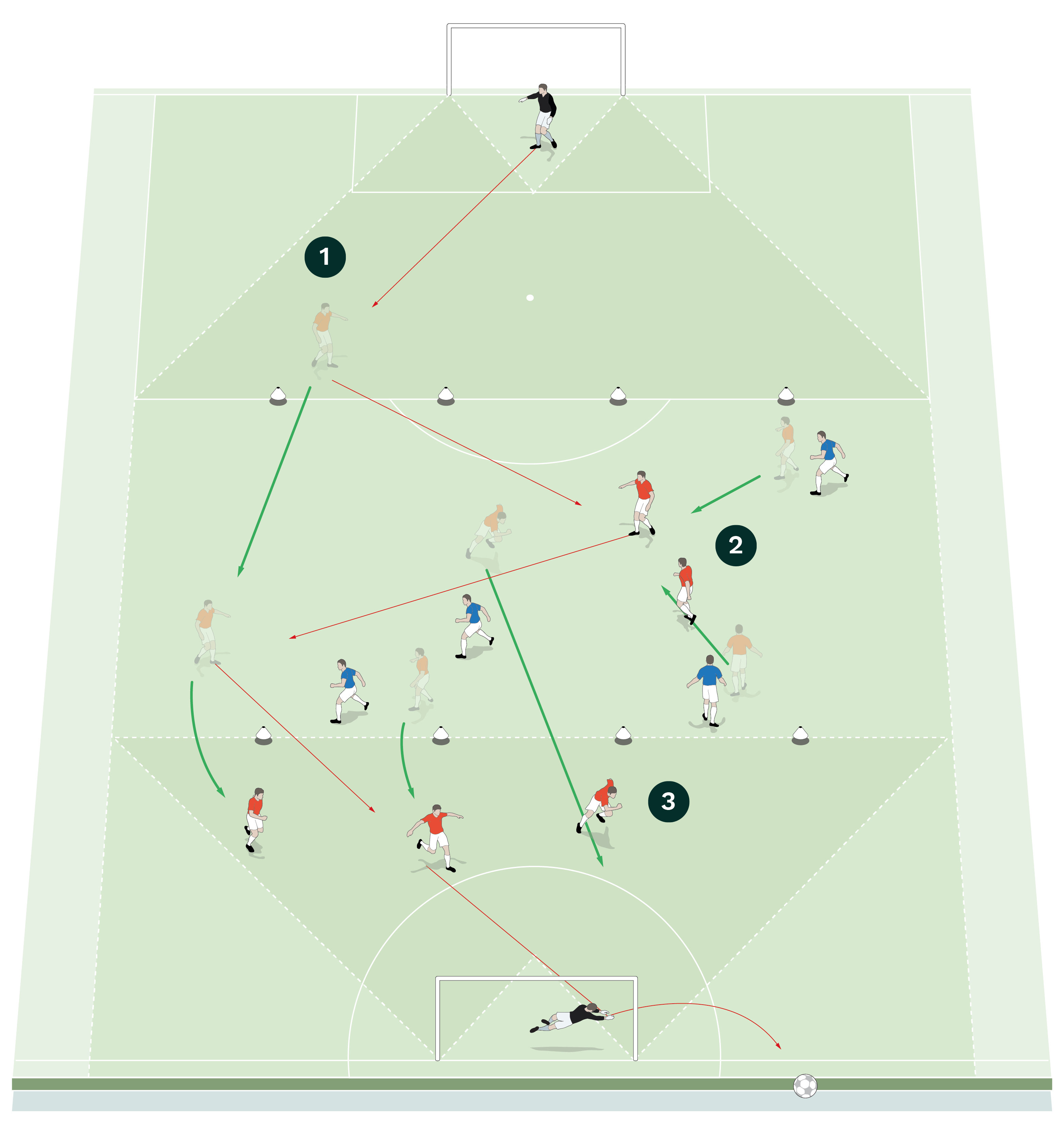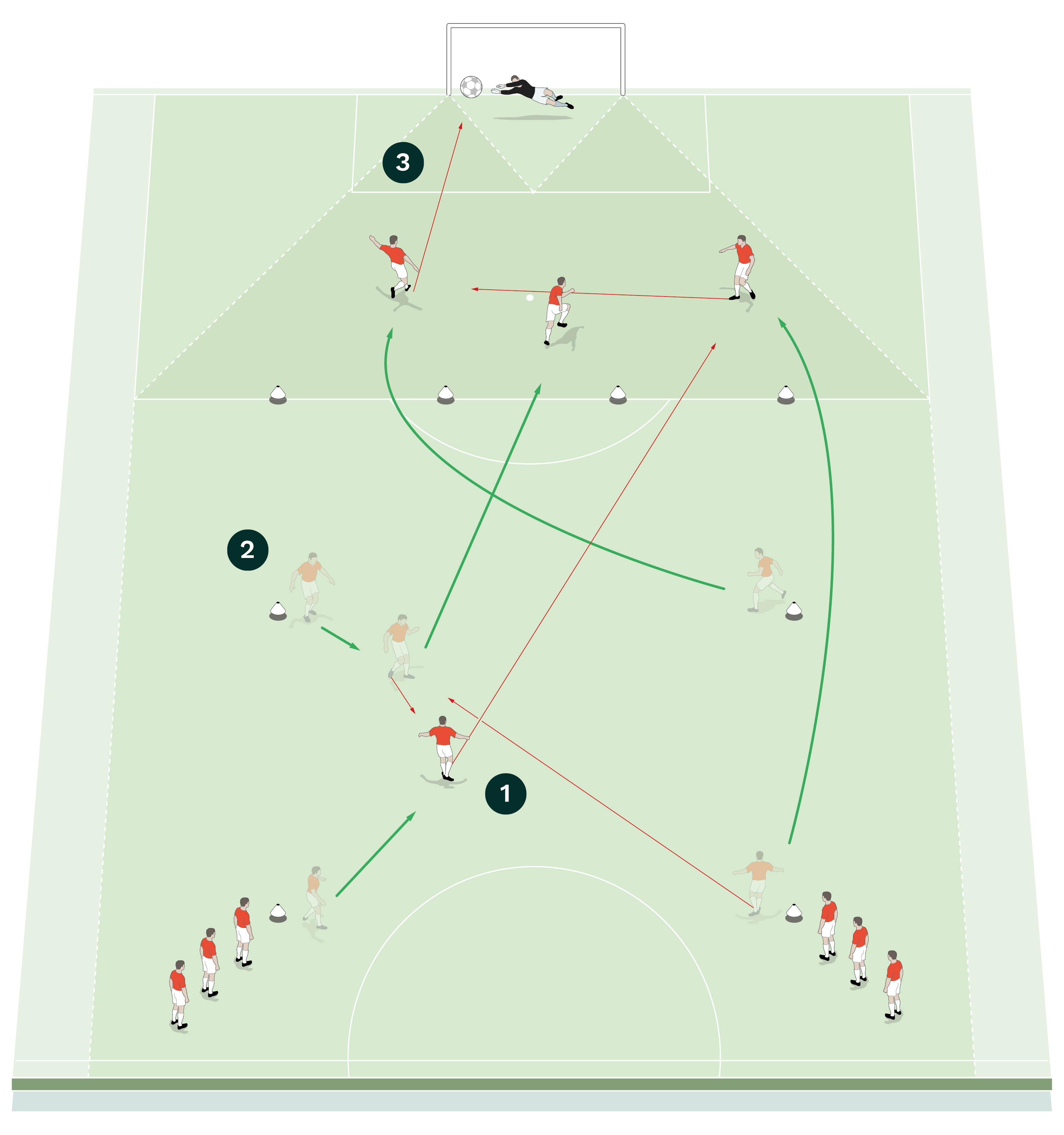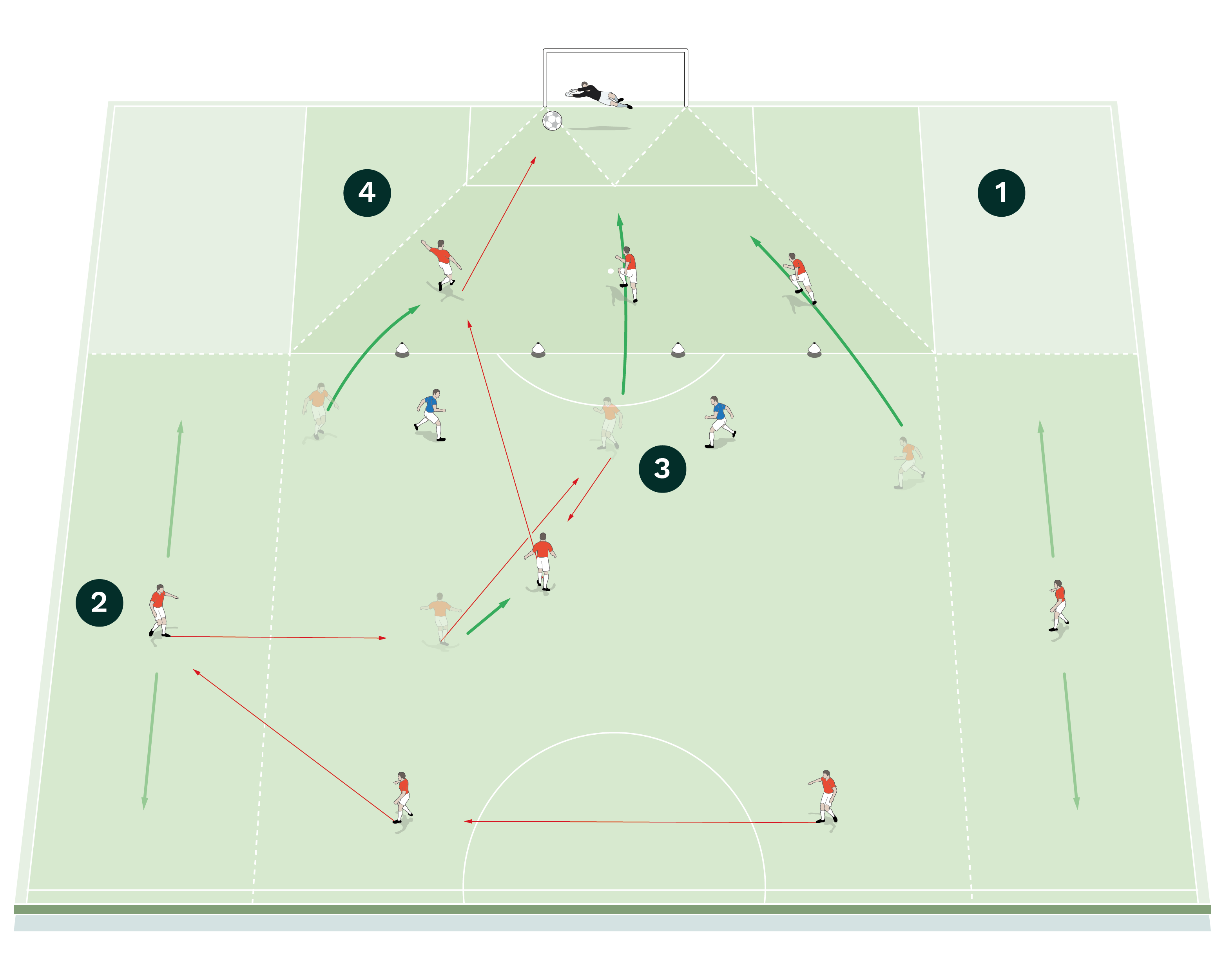You are viewing 1 of your 1 free articles
Getting into the 'Big W' to score
| Area | Up to half a pitch |
| Equipment | Balls, bibs, cones, flat discs, 2 full size goals |
| No. of Players | Up to 12 players + 2 goalkeepers |
| Session Time | Passing and movement: 15mins The ‘Big W’ game: 15mins The ‘Big W’ drill: 15mins Attacking the ‘Big W’: 15mins |
This training session is all about coaching players to understand how and why they need to get into the correct area – the ‘Big W’, as I call it – to give them the maximum opportunity to score goals for the team.
The ‘Big W’ is effectively the penalty area but for training purposes we funnel the attacking players directly towards the goal for maximum impact.
The whole squad tends to enjoy this training session because it can be used for the benefit of every player in the squad, whatever position they play in.
It is used to encourage the team to play the ball forwards and advance up the pitch into the ‘Big W’ area. All players love to score, even defenders, and this session gives them plenty of opportunities to do this.
It encourages players to show they have no fear of making forward runs and shows them they can succeed in scoring as long as the passing is of a high standard.
These passing activities can become the foundation of every session as a warm up. They also show players the philosophy of the team, using high quality passing at a fast tempo.
“This session encourages players to show they have no fear of making forward runs and shows them they can succeed in scoring as long as the passing is of a high standard”
PASSING AND MOVEMENT
We set up a playing area of 40x20 yards. We’re using 12 players who work in pairs to produce combination play in this passing and movement exercise. The blue pair are strikers and are positioned in the centre of the area, while the remaining players start in pairs at either end, as shown. The exercise works in both directions.
Play starts at the bottom of the playing area with a pass being played into one of the blue strikers by a player from the first red pair. The blue striker sets the ball off to the second player from the first red pair, who then plays a through pass into the path of his forward running team mate who started the passing pattern.
The pattern continues with a pass being played across into the second blue striker, who has made a diagonal run to create space for the initial through pass. The passing and moving continues as shown [1a] until the ball is worked to one of the waiting players at the top end of the playing area.
The exercise is then repeated from the opposite end of the area, with the same passing pattern being executed by the players in the other direction. Players should use one-touch only whenever possible, as shown [1b].
[1a]

2. The blue striker sets the ball off to the second red player, who then plays a through pass into the path of his forward running team mate
3. The first red passes across into the second blue striker who has made a diagonal run to create space
4. The pattern finishes when the ball is played to one of the waiting reds at the top of the playing area
[1b]

2. The player who receives the finishing pass of the first pattern plays a starting pass to the blue striker and the same pattern is executed in the opposite direction
3. Players should use one-touch only whenever possible
“Players work in pairs to produce combination play in this passing and movement exercise”
THE ‘BIG W’ GAME
We set up a playing area on half a pitch with a goal and a goalkeeper at each end, coned off to the width of the penalty area. An 18-yard box is marked in front of each goal, with four cones placed along each 18-yard line. The area of the ‘Big W’ is marked with flat discs at each end. We’re using 10 outfield players split into two teams of five.
Play starts with a pass out from the keeper. We play a 5v5 game in the central area of the pitch, with the team in possession aiming to enter the area of the ‘Big W’ (the penalty box) by playing through balls beyond the cones for forward-running attacking players to capitalise on. When a player receives the ball in the ‘Big W’, they have one-touch only to finish past the goalkeeper, as shown [2a].
[2a]

2. Play a 5v5 game in the central area, with the team in possession aiming to enter the ‘Big W’ area of the penalty box by playing through balls beyond the cones for a forward to run onto
3. When a player receives the ball in the ‘Big W’, they must finish past the goalkeeper with a first-time shot
[2b]

2. The aim is to use combination play through the centre of the pitch to create the chance to play a through ball into the penalty area
3. Progress the activity by requiring three attacking players to be inside the ‘Big W’ for a goal to count
The game is directional and the aim is to produce combination play through the pitch to enter the ‘Big W’ and score a goal.
We can progress the activity by requiring three attacking players to be inside the ‘Big W’ for a goal to count, as shown [2b].
“The target is to get three players into the ‘Big W’ during each attack for a goal to count and the shot must be taken first time”
THE ‘BIG W’ DRILL
We set up a playing area on half a pitch coned off to the width of the penalty area, with a goal and goalkeeper at one end. The area of the ‘Big W’ is still marked with flat discs in front of the goal.
This exercise is a progression from the first passing pattern and links to the previous game. Players attack in pairs using the same passing pattern as used in the first exercise to combine with a pair of strikers. The aim is to get three players entering the ‘Big W’ at the same time, creating a goal-scoring opportunity for any one of them, as shown [3]. Alternate the side of the starting pass.
[3]

2. The starting pair combine with a pair of strikers up the pitch. The aim is to get three players entering the ‘Big W’ area at the same time
3. The drill should end with a first-touch shot on goal with three players inside the ‘Big W’
ATTACKING THE ‘BIG W’
We use the same playing area with the ‘Big W’ still marked with flat discs in front of the one goal and goalkeeper, but we add wide channels to either side, as shown.
We’re using 10 outfield players, split into a red attacking team of eight and two blue defenders. The eight red attacking players are set up as part of a 4-3-3 formation, with two supporting full backs operating in the wide channels. The full backs are free to receive the ball in the wide channels and pass back inside the central area.
The aim for the team of eight attacking players is to produce combination play to move the ball beyond the two defenders and the four cones positioned on the 18-yard line in order to enter the ‘Big W’ and score a goal, as shown [4]. Once again, the target is to get three players into the ‘Big W’ during each attack for a goal to count and the shot must be taken first time. To be successful, players must time their runs well to break the final defensive line.
After each attack is dead, players must reset and attack again.
[4]

2. Two red full backs can support play from the wide channels
3. The aim for the reds is to use combination play to move the ball beyond the two blue defenders and enter the ‘Big W’ area
4. Three attacking players must be inside the ‘Big W’ for a goal to count and the shot must be taken first time
COACHING POINTS
What are the key things to look out for?
The key points to look out for are: the quality of pass and the quality of control, the timing of support runs, and the timing and speed of the pass. It’s also important that players use the correct choice of finish when a goal-scoring chance is created – they should demonstrate they know when to pass the ball into the net, when to place their shot with accuracy and when to hit the ball with power.
What are the typical mistakes players might make and how do I avoid them?
Players can’t avoid making mistakes, they can only improve their performance over time, with plenty of effort and experience.
Common mistakes that players make during this session include receiving the ball square on, instead of side on. Also, players can control the ball poorly with their first touch, putting it into the wrong place for the next pass.
Other common mistakes include making poorly timed support runs and selecting the wrong finishing option to score.
To help players understand the session fully, it’s okay for coaches to walk them through the practice to begin with.
Related Files
Editor's Picks
Deep runs in the final third
Using the goalkeeper in build-up play
Pressing principles
Intensive boxes drill with goals
Penetrating the final third
Creating and finishing
My philosophy
Pressing initiation
Compact team movement
Coaches' Testimonials

Alan Pardew

Arsène Wenger

Brendan Rodgers

Carlos Carvalhal

José Mourinho

Jürgen Klopp

Pep Guardiola

Roy Hodgson

Sir Alex Ferguson

Steven Gerrard
Coaches' Testimonials

Gerald Kearney, Downtown Las Vegas Soccer Club

Paul Butler, Florida, USA

Rick Shields, Springboro, USA

Tony Green, Pierrefonds Titans, Quebec, Canada
Join the world's leading coaches and managers and discover for yourself one of the best kept secrets in coaching. No other training tool on the planet is written or read by the calibre of names you’ll find in Elite Soccer.
In a recent survey 92% of subscribers said Elite Soccer makes them more confident, 89% said it makes them a more effective coach and 91% said it makes them more inspired.
Get Monthly Inspiration
All the latest techniques and approaches
Since 2010 Elite Soccer has given subscribers exclusive insight into the training ground practices of the world’s best coaches. Published in partnership with the League Managers Association we have unparalleled access to the leading lights in the English leagues, as well as a host of international managers.
Elite Soccer exclusively features sessions written by the coaches themselves. There are no observed sessions and no sessions “in the style of”, just first-hand advice delivered direct to you from the coach.









